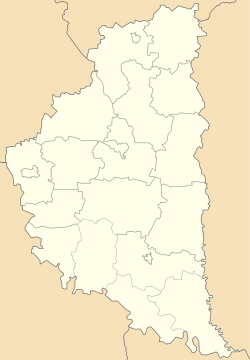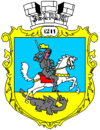Zbarazh
| Zbarazh Збараж | ||
|---|---|---|
| City | ||
|
| ||
| ||
 Zbarazh Location of Zbarazh in Ukraine | ||
| Coordinates: 49°40′0″N 25°46′40″E / 49.66667°N 25.77778°ECoordinates: 49°40′0″N 25°46′40″E / 49.66667°N 25.77778°E | ||
| Country |
| |
| Oblast | Ternopil | |
| Raion | Zbarazh Raion | |
| First mentioned | 1211 | |
| Population (2013) | ||
| • Total | 14,004 | |
| Time zone | EET (UTC+2) | |
| • Summer (DST) | EEST (UTC+3) | |
Zbarazh (Ukrainian: Збараж, Polish: Zbaraż, Yiddish: זבאריזש Zbarj) is a city in the Ternopil Oblast (province) of western Ukraine. It is the administrative center of the Zbarazh Raion (district), and is located in the historic region of Galicia. The current estimated population is around 13,000.
Zbarazh is one of the settings of Henryk Sienkiewicz's novel With Fire and Sword (1884) in which he gives a detailed description of the famous Siege of Zbarazh. Notable Jewish residents included rabbi Zev Wolf, the singer Velvel Zbarjer and the author Ida Fink.
History
First attested in 1211 as a strong Ruthenian fortress, Zbarazh became a seat of the Gediminid princes Zbaraski towards the end of the 14th century. Ruins of the original castle are extant in the vicinity of modern Zbarazh.
Following the 1569 Union of Lublin, Zbarazh became part of Kingdom of Poland's Krzemieniec County and Volhynian Voivodeship. After the first partition of Poland (1772), the town was seized by the Habsburg Monarchy, and remained in the province of Galicia until 1918. In the immediate post-World War I period, a Polish–Ukrainian War took place in Eastern Galicia. After the conflict, Zbarazh returned to Poland, becoming the seat of a county in Tarnopol Voivodeship. In the interbellum Second Polish Republic, it had the population of 8,000, with Jewish, Polish and Ukrainian communities.
After the World War II, the town was annexed by the Soviet Union and is now part of Ukraine.
Points of interest
Throughout the centuries, Zbarazh was the capital of the properties of the Zbaraski family. After the line had ended, the town was transferred to the Wiśniowiecki family. It also belonged to the Potocki family. The new Zbarazh Castle was designed for Prince Jeremi Wiśniowiecki in a post-Palladian Italian idiom similar to Scamozzi's by the Dutch architect van Peyen in 1626–31. The castle was partly rebuilt in the 18th century. A palace constructed for the family is located in the nearby town of Vyshnivets.
Zbarazh also preserves several remarkable churches, notably the Saviour Church (1600) and the Bernardine Monastery (1627). The Zbarazh Fortress was twice besieged by the Crimean Tatars (1474, 1589). After the second siege, a new castle was completed in 1626. In 1649, during the Khmelnytsky Uprising, the castle was besieged by the Cossacks and their Tatar allies. Defended for 43 days by Polish troops under Jeremi Wiśniowiecki (10 July–22 August), it was not captured.
The local Roman Catholic church was funded in the mid-17th century by Janusz Wisniowiecki. Destroyed by the Ottoman Turks in 1675, it was rebuilt in 1755, together with a new monastery. In the main nave of the church there was a commemorative plaque in memory of the 100th birth anniversary of Adam Mickiewicz. In the interbellum period, Bernardine monks from Zbaraz operated a middle school here. Both the church and monastery were not destroyed during World War II, after which local Poles were ordered to move to the Recovered Territories, and Soviet authorities began a process of devastation. In the monastery a hospital, later a plant were located, while the church was turned into a warehouse. Some items were saved by the Polish residents, who removed and took them to Poland in 1945. Currently, these items are kept in Bernardine churches in Leżajsk, Rzeszów and Alwernia.
After the collapse of the Communist system, the church was handed back to the monks. A first service took place on 3 September 2000.
Notable people
- Ignacy Daszyński (1886–1936), Polish politician
- Ida Fink (1921–2011) Israeli-Polish writer
- Meshullam Feivush Heller (c. 1742–1794), Hasidic author
- Dmytro Klyachkivsky (1911–1945), also known as Klym Savur, Ukrainian Insurgent Army commander
- Karol Kuryluk (1910–1967), Polish social activist
- Ivan Prasko (1914–2001) Ukrainian-Australian Greek-Catholic bishop
- Zev Wolf (died 1822), rabbi
- Velvel Zbarjer (1824–1884), broder singer
Gallery
- City hall
 Resurrection Church
Resurrection Church- Old cemetery entrance in Zbarazh
- Church of Dormition
 Palace inside Zbarazh Castle
Palace inside Zbarazh Castle

